At Showpad we believe the best customer experience wins, and in this article, I’ll explain two common gaps that drive poor buying experiences; customer knowledge variance, and the revenue enablement gap.
I believe revenue enablement can go some way to bridging these gaps, so I’ll cover the four pillars of revenue enablement and share how we think about revenue enablement and what it actually should be doing for our customers.
My name's Louis Jonckheere, I'm the co-founder and president of Showpad, and in this article, I'll discuss how to close the gap between revenue teams and align your customer-facing teams to deliver the best possible buyer experience.
Showpad is a sales enablement platform that helps our customers deliver the best possible sales interactions and conversations to their customers.
The best customer experience wins
This is something we truly believe in as a company and something that’s really driving a lot of success and change across B2B organizations across the world.
Convenience
This for me is the first driver of a great customer experience. From the B2C world, we've learned that technology made it easier and more convenient to buy something to get from A to B, to order a meal, etc.
Think about anything – technology has made it extremely convenient for us.
Think about selling B2B and buying, is this convenient enough? Are you a convenient business to work with in your sales and buying processes? That's something to really think about when you deliver on your customer experience.
Exceptional value
The second piece is exceptional value, are you delivering value at every single touchpoint of your customer journey?
Every interaction you have with a customer needs to deliver personalized, unique, exceptional value. If you do not do that you're wasting your customer's time.
Convenience and exceptional value are two key drivers of what is in my opinion, a very strong customer experience.
Customer experience is the current battleground
This is a number from a few years ago, I think especially given the pandemic and all of the digital change we've seen, it's the current battleground.
That's trumping product, trumping price, and making sure customers choose your product or service to work with and not your competitors.

We are today on this battleground and it's time to up our game. But we're still not there yet.

A 2019 study by Gartner showed more than 75% of buyers feel that it's too complicated and too time-consuming to buy something from you, as a business, very specifically in B2B.
So we have to buckle up, we have to do more, we have to think deeper about how we can make buying easier for our customers.
We aren’t organized to deliver unified buying experiences
The first thing I want to talk about is the silos, I think we all see that one of the big hurdles to delivering a great customer experience is the fact that we work in silos.

Every silo has its version of the truth, its strategy, and its way of thinking about the customer and the go-to-market strategy.
We need to change this, we need to bring those silos together around unified metrics, processes, and technology, which I'll talk more about later.
We don’t have the tools to deliver a unified buying experience
We don't have the technology today to make that happen. Your CMS system or your CRM, your marketing automation platform doesn't help you to deliver a consistent customer experience across all of those silos.

This is where we believe sales enablement technology really fits in. There are two gaps that I would like to talk about that drive, in our opinion, a poor buying experience across all of your channels.
Two gaps that drive poor buying experiences
The first one I want to talk about is customer knowledge variance.
Customer knowledge variance
Customer knowledge variance is about the idea that every single department has a very different view of what customer knowledge is, who their customers are, and how to approach them.
Where is my customer knowledge?
If we ask the question where is my customer knowledge? It's spread across different systems and it's spread across different teams. It's in your CRM system, a million Excel sheets, your surveys, meeting notes, and market research, it's everywhere.
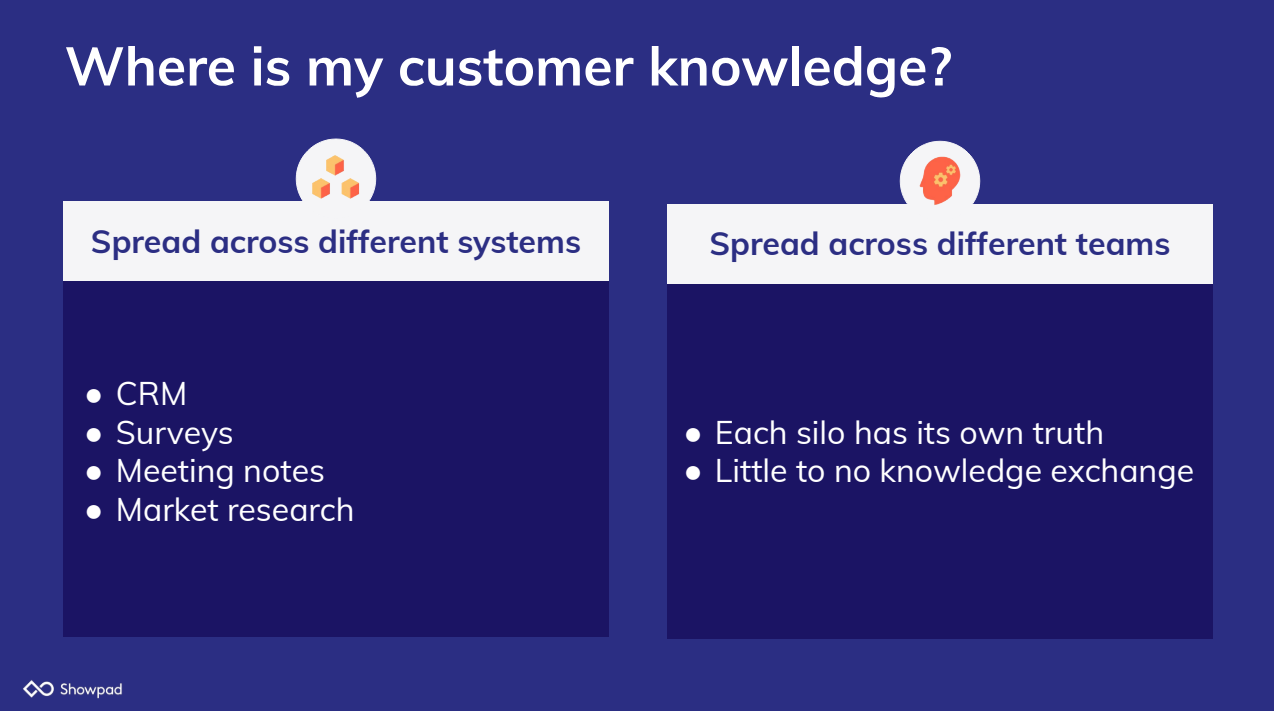
It's not centralized. It's also not evenly spread across teams. Every silo has its own version of the truth and there's very little collaboration in really understanding who the customer is.
I believe companies are making progress on that but most companies that I start working with, when I ask that question, don't have a great answer – it's spread across systems and teams with very little collaboration.
How accurate is my customer knowledge?
The second question is how accurate is your customer knowledge? From our perspective, the most accurate customer knowledge you can capture is the sales conversations and customer conversations you have.
But today 95% of that information gets lost because we rely on meeting notes and opinions. And because we use those opinions and meeting notes and share them until we have a dumbed-down version of what actually has happened in a specific conversation.

Sales conversations are one of the most important knowledge sources that you have as a company. I'll talk about how to actually deal better with that.
Ramifications
If you then go a bit deeper customer knowledge variance has major ramifications.
- Marketing doesn't really understand the customer so the messaging and content they create is ineffective.
- Sales, who have to deliver that value messaging to the customer, are unable to articulate a unique value because they really don't understand the customer.
- Your customer experience organizations are unable to show that unique value to customers to make sure they see the value of your product and service, and ultimately renew or stay with you for the rest of their lives.

Customer knowledge variance has huge major ramifications that we really need to think about.
Revenue enablement gap
The second gap we see that drives a poor buying experience is the revenue enablement gap.
This is a simple one, it starts from your customer, your buyer expects a buyer experience that's very consistent across all of your channels; sales, service, CX marketing, your partners, etc.

It doesn't make any sense to just enable your sales team to have great conversations, you need to do that with every single actor in your business who interacts directly with a customer.
Very important to think about the topic of alignment – inconsistency will become really important here, which I'll talk about later.
Revenue enablement is about equipping your revenue teams with the right knowledge, skills, and tools to acquire and grow customers efficiently and effectively.
The keyword for me here is effectively – get more out of the conversations you have with your customers, don't focus on getting 10x more meetings, but make sure the ones you have are more effective.
Now I'll talk about revenue enablement because in our view, revenue enablement fixes or bridges some of the gaps that I've talked about – customer knowledge variance and the revenue enablement gap.
I'll share how we think about revenue enablement and what it actually should be doing for our customers.
The four pillars of revenue enablement
It's about knowledge and gaining knowledge. If you think about the idea of knowledge and making your sellers and customer-facing teams knowledgeable, there are a few key items I want to touch upon here.
1) Make your content findable
First of all, as an organization – and this is where sales enablement technology can help - make your content findable.
Make sure your sellers can find what they're looking for in search, browsing, and filter.
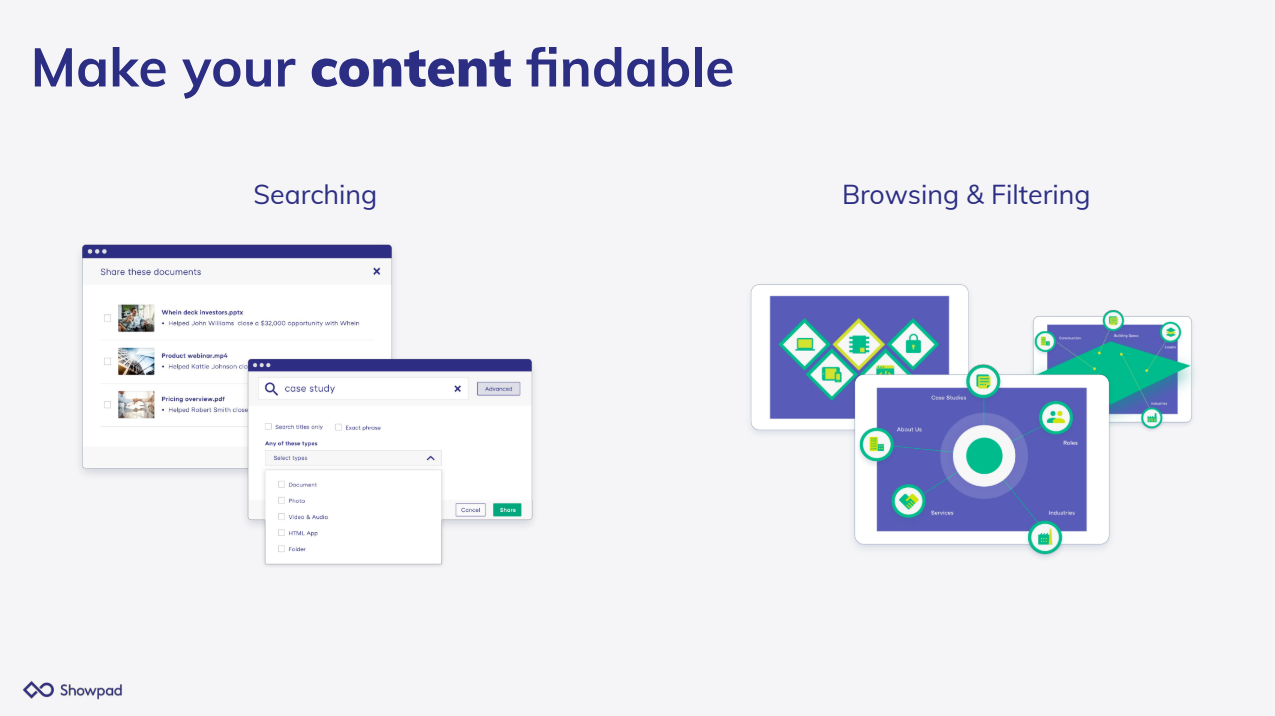
Bring your content and logic in a user interface that actually helps sellers find very quickly what they need. Make it findable for us is step one, in terms of content.
2) Make any relevant knowledge snippets findable
Secondly, we strongly believe in the idea of knowledge snippets. If you have a question, as a salesperson, and you want to have a quick answer.
For example, with regards to competitive intelligence or an RFP, invest in a snippet or in a knowledge snippet database, which can be served to salespeople.

Content is a big driver of knowledge, like little snippets, which is again, something technology like Showpad can help you with can bring knowledge to salespeople faster. That's the second piece.
3) Guide sellers through plays
Plays, for me, are a game-changer in the world of sales enablement. They're basically playbooks that start from achieving a specific goal. Let's say that you want to sell a new product to your customer base, make that very specific, that's the goal.
Then really focus on the target and the characteristics of the customers you want to sell to. Then make sure you're very consistent about the knowledge, the battle cards, the messaging, the tools they can use, and the experts in the business that can help you in answering some of the questions.

The idea of a play is that you bring together all of the knowledge, all of the tools, and all of the guidance together in a single interface that's going to really guide salespeople to make sure they ask the right questions, they show the right presentations, and they see the right things at the right moment.
Plays are a really important piece of sharing knowledge with your customer-facing teams.
4) Deliver contextual (micro-)training
The last piece for us is training. Again, training is something we do when we onboard when we have a new product launch when there's a new initiative, and we see a huge move in the space towards micro contextual training.
Small knowledge snippets that are delivered to salespeople when they actually need it, and not just at a moment in time when we want to organize training.

Contextual micro training at the point where they need it, and in a format that they actually want to consume it. We see a lot of our customers at Showpad moving to a world where training is something that happens continuously, and not just at specific moments in time.
That's the knowledge piece within revenue enablement.
Engage with buyers
Your customer-facing teams need to have tools to engage with their customers in a very personalized and interactive way.
What makes a customer conversation great
If you think about customer conversations and what makes them great, it's about storytelling, value, and collaboration. It's something that we've learned, as B2C sales and marketing organizations, to be super important.

Due to the COVID pandemic, we were confronted with the reality of moving from field sales to virtual selling, and in a very disruptive way, we had to change gears and become experts in that.
Deliver your story in an engaging way
I believe that we need to build very similar expertise and level of innovation in virtual sales conversations that we have in in-person meetings.
We need to think about improving them. I mean, if we're really honest here then virtual storytelling has its limits.

Visual storytelling has its limits
We're basically looking at a full-screen slide deck and the seller is that small, it doesn't always deliver the best customer experience that your customers expect.
I think there's a lot of room for improvement and we believe that sales enablement technologies have a very important role to play there.

Becoming experts in virtual storytelling
At Showpad we're continuously innovating, adding capabilities, and adding innovation on top of that.
Already today, you have capabilities, for example, with Zoom and a lot of their marketplace innovations such as adding interactive backgrounds and sharing interactive content with your customers.
I believe today, we're just setting the first steps and becoming experts in virtual storytelling and I do expect a tonne of innovation in the market from a lot of players including sales enablement platforms.
Virtual storytelling is the first piece I want to talk about.
From email to personalized buyer portals
When it comes to engaging your customers, we strongly believe at Showpad in the idea of buyer portals.
Email isn't a good tool to collaborate with your customers, especially now that we have a selling team and a buying team.
It needs to be brought together in a portal that drives collaboration, personalization, and ultimately buying power.
From email to personalized buyer portals, what we see with a lot of customers out there is the B2B organizations who embrace that idea of a buying portal deliver much more revenue. Up to 28% higher revenues. This is the buyer portal.
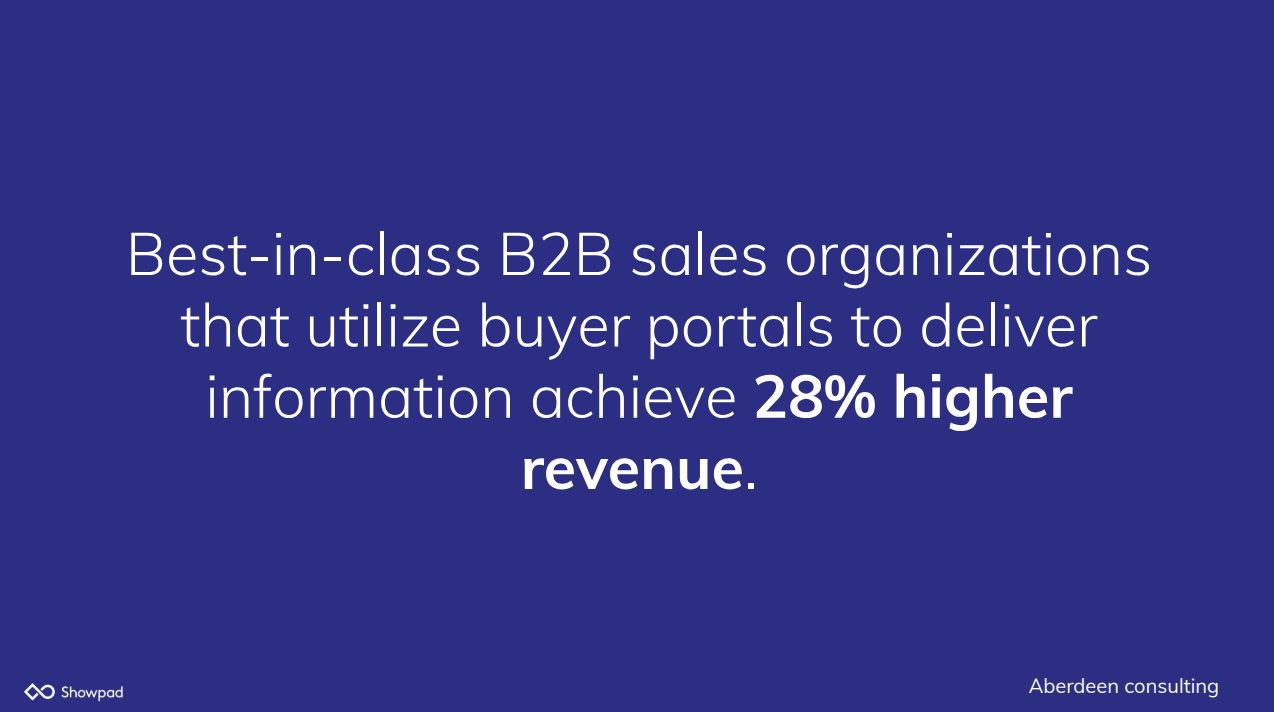
Again, the buyer portal delivers you improved content findability for your customers, and better personalization, and you can use it across the whole customer journey.
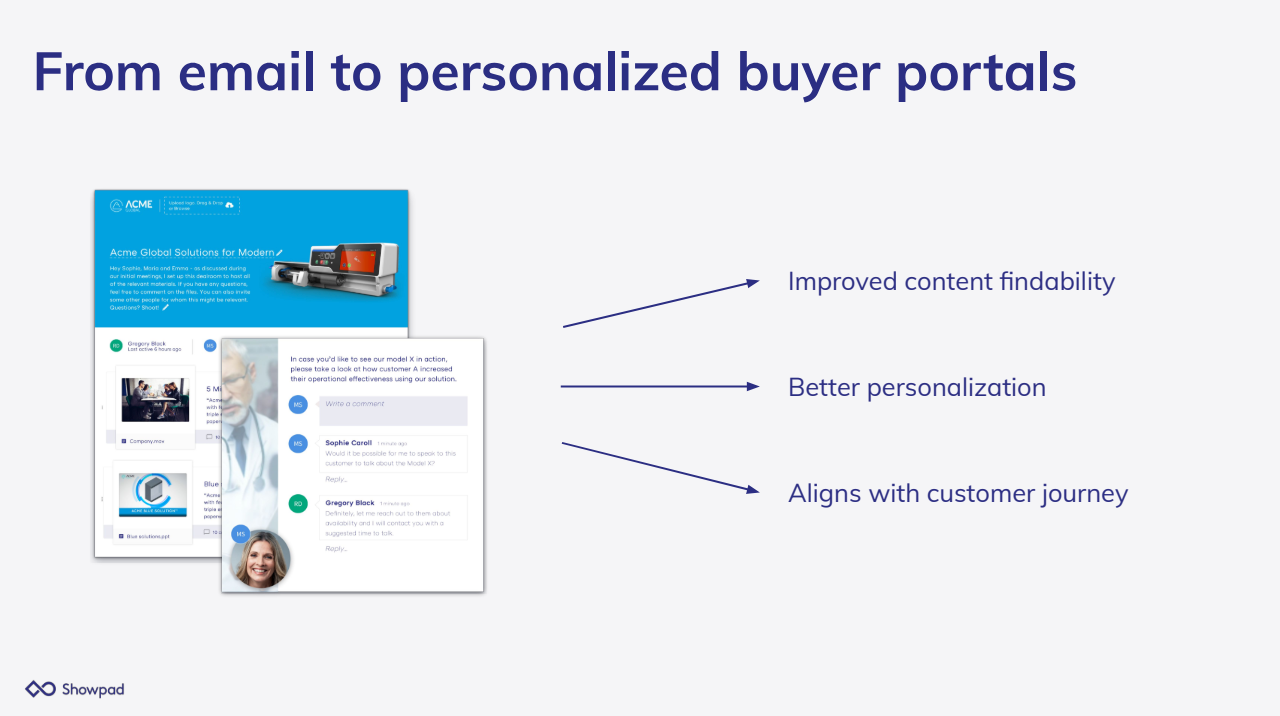
Those are two aspects of customer engagement we really think are going to be key to drive customer experience; virtual storytelling, and ultimately much better buying portals that your salespeople – your customer-facing employees – can set up and use across the customer journey.
Be coached on skills
Yes, your sales team and your customer-facing teams need knowledge, they need to have tools to engage with customers, but they also need to be coached on the skills.
They need to be coached on skills to be better salespeople, to be better customer success professionals.
Coaching changed drastically overnight
We all went through a reality where coaching suddenly had to happen virtually.
We moved away from the watercooler conversations where we coached our colleagues or our manager coached sales reps at their desks when they closed the deal or lost the deal.
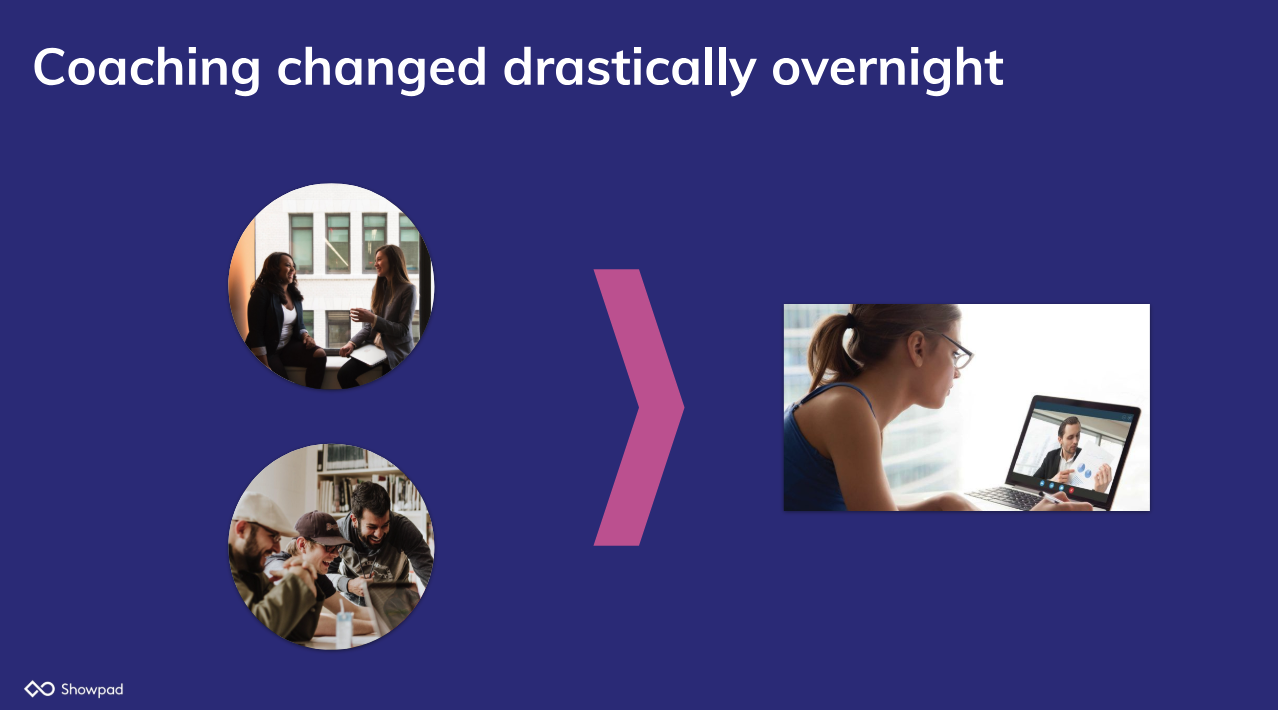
There are a few areas I would like to focus on and share our ideas on how coaching really should be driven in a revenue enablement platform.
Sales managers don’t focus enough on coaching
First of all, this is really a reality that we see with lots of our customers and companies out there – we don't spend enough time coaching our sellers or customer success people.
Half of the managers only spend less than 30 minutes per week coaching somebody.

If you think about it that's super low, especially knowing that coaching can deliver such an amazing upside.
The impact of coaching on quota attainment
As you see here, the impact of coaching on quota attainment is massive.
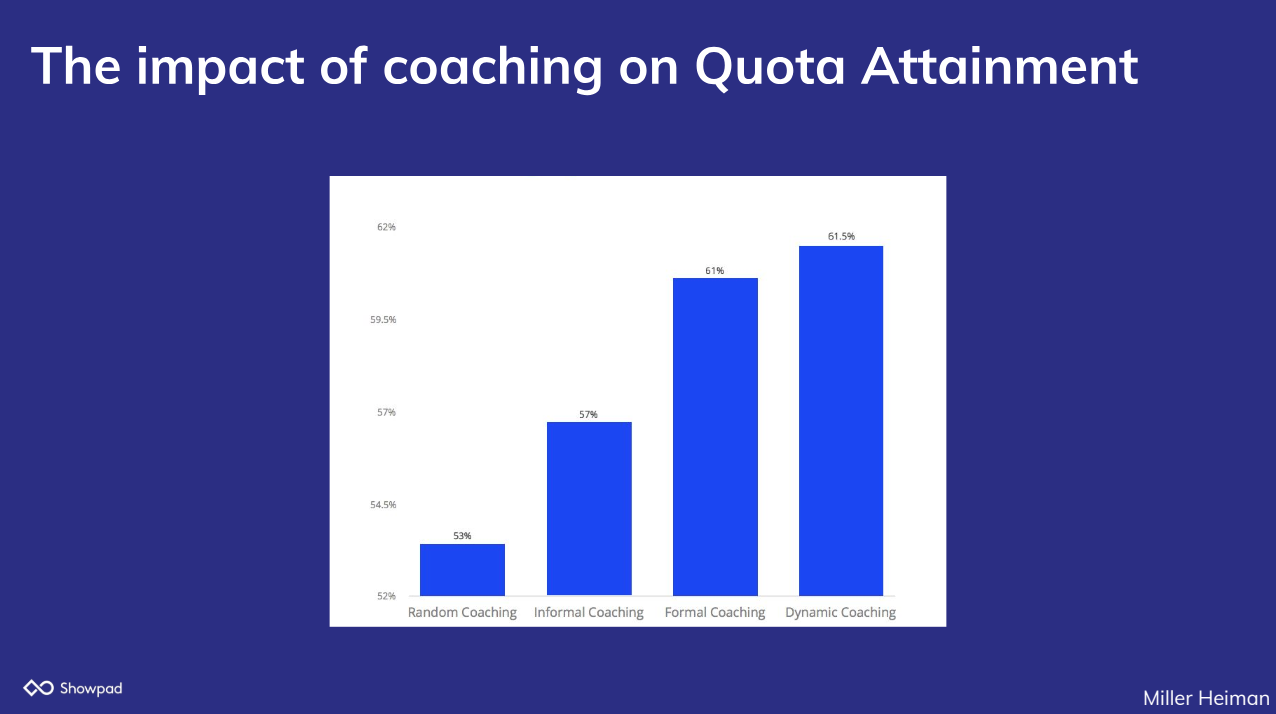
If you move from random coaching where a lot of customers and companies are, to a dynamic form of coaching, you really start to have a massive uplift in your revenue.
This is a great study from Miller Heiman and if you Google it there are lots more interesting data points to find. But coaching works, coaching drives business value and drives success.
Yet, we don't do it enough, we don't have it formalized, and we do not know how to do it in a virtual environment.
Guide reps from tests to practicing
The first thing that we see at Showpad is we need to move from just giving sellers tests to giving sellers practice environments, giving sellers digital environments to:
- Practice their pitch,
- Record themself through video,
- Write an email,
- Do a roleplay,
- Do a voiceover on deck,
And then share that with their manager and with their peers to get specific feedback and specific coaching.

A massive improvement I see in the world of coaching is that sellers can actually practice something and then get feedback and coaching based on what they've produced.
If you think about it, it's fundamentally much more interesting, much stronger, and more effective than just typing in the dust, which ultimately, isn't that effective.
Coach sellers on their practice assignments
The second thing is you can then basically coach your sellers, as I've mentioned, on those practice assignments.
I've recorded a pitch and sent that to my manager, my manager now can give me feedback, and they can score or rate me based on very specific criteria.

You can share those examples with the rest of your team and if you have great practice assignments and great practice pitches, the manager can decide to share them with the broader team so they can use that knowledge to make their pitch better.

Super important that you close the loop there.
Start recording your customer meetings
I strongly believe customer meetings truly hold exceptional value in terms of coaching yourself.
If you start recording your customer meetings, the first thing you'll notice is many of your customers won't have an issue with that, they're more and more accepting of recording customer conversations.
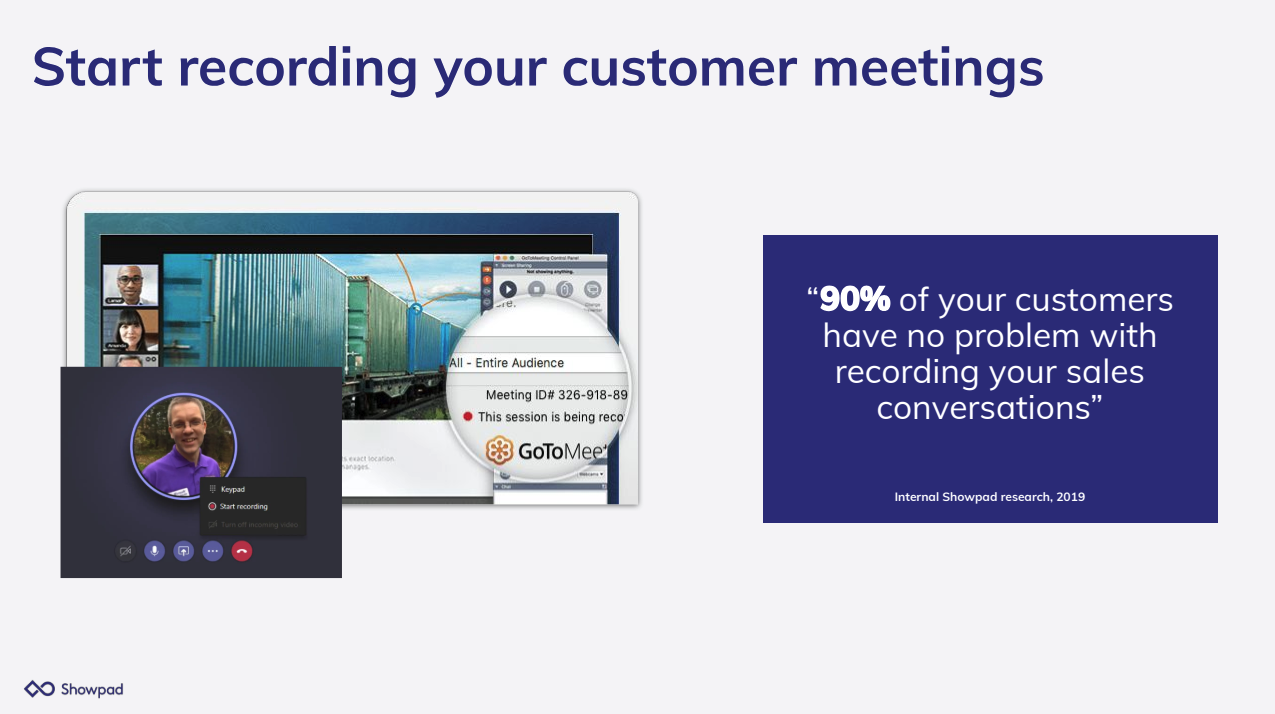
If you use conversation intelligence, which is a capability built into the Showpad platform, you can automatically record meetings through Zoom, etc., get the recording into your enablement technology, and get the transcription.
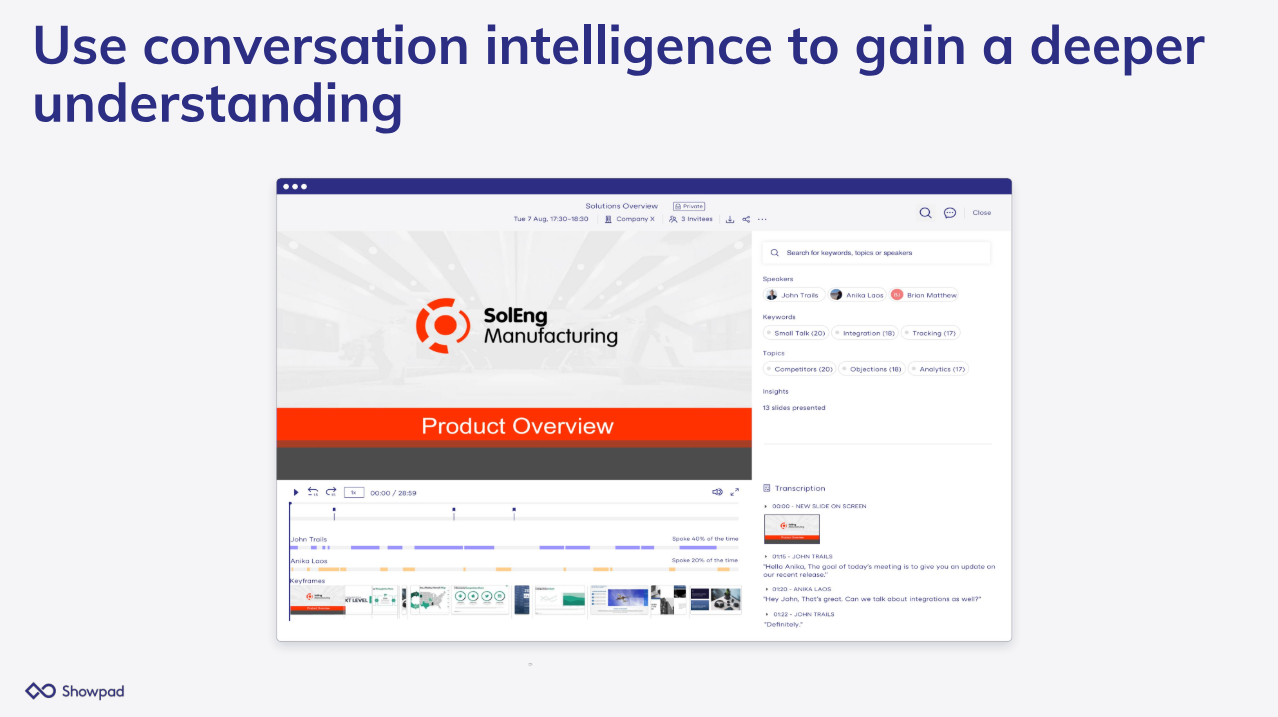
A very important piece of making sure you capture that knowledge inside of the platform.
Deliver high-impact coaching with meeting recordings
But then, of course, you use those recordings to deliver high-impact coaching.
You use those specific pieces of recording, let's say the pricing negotiation or the product introduction, you take a snippet of that, and then the manager and the seller have a conversation about that interaction and get very specific and tangible coaching.

Based on real-life scenarios of salespeople, customer-facing employees really can get coaching and feedback which has the highest impact.
So, gain knowledge, engage buyers, and be coached on skills – three very important drivers of revenue enablement.

At the center we then see revenue intelligence, because, in a sales enablement platform, your sellers will consume knowledge, they'll engage with customers, through virtual meetings, buyer portals, email, personalized content, etc., and they'll be coached.
That's delivering us a massive amount of intelligence and data that we want to capture and want to give to our customers.
Harness the power of revenue intelligence
If you think about the idea of revenue intelligence, then basically there's content intelligence and the idea that you start to get insights on how your content is performing and how you can create better content.
If you then think about engaging buyers that translates into buyer intelligence:
- How's your customer responding to sales conversations and specific offers?
- How do they feel about the product, about the competitive environment?
You can get intelligence out of those interactions. And then ultimately, as well, people intelligence:
- Who are the best performers in our company?
- And how can we use what we've learned there to coach the rest of the sales team to actually be at that level?
Revenue intelligence ultimately will drive a ton of insight and a tonne of change for a lot of revenue teams out there.
Summary
To reiterate, we see two gaps that really drive alignment between revenue teams, and deliver success.
First of all, the customer knowledge variance. Customer knowledge is not evenly spread in different systems, and it's open to being inaccurate.
Secondly, the revenue enablement gap. This starts from the idea that your customer, your buyer, wants to have a consistent customer experience across all channels.
That's where revenue enablement comes in. It's about gaining knowledge, engaging with your buyers, being coached on skills, and then ultimately having the intelligence from your revenue organization that drives content intelligence, buyer intelligence, and ultimately, people intelligence.



 Follow us on LinkedIn
Follow us on LinkedIn


